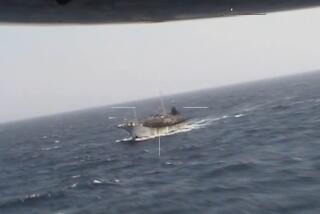Chinese Navy Scores a First in U.S. Visit
- Share via
SAN DIEGO — In a sign of their country’s recent military buildup, three Chinese warships sailed smoothly Friday morning into a glistening San Diego Bay for the first visit to the United States mainland by a Chinese naval ship.
Taking the lead in entering the bay--the West Coast home of the U.S. Navy--was the guided missile destroyer Harbin, the newest, largest and most advanced ship in the Chinese navy, which until a few years ago lacked ships capable of venturing more than a few hundred miles offshore.
“The Chinese are very conscious of symbolism, and this visit is their way of telling the world that they are truly a global power,” said Ralph Cossa, executive director of the Honolulu-based Pacific Forum think tank.
As a U.S. Navy band played a selection of Americana, including jazz and John Philip Sousa marches, and hundreds of Chinese Americans waved flags from both countries, the three pale green ships of the People’s Liberation Army Navy moored at North Island Naval Air Station in Coronado.
The visit of the Harbin, an older destroyer called Zhuhai and the supply ship Nancang underscores the changeable nature of geopolitics on the Pacific Rim.
A year ago, the Harbin was among a group of ships that engaged in a tense confrontation with the U.S. Navy. That incident began when the Chinese conducted a live-fire naval and amphibious landing exercise near Taiwan that some diplomats believed was designed to intimidate and blockade the island nation.
In a show of support for Taiwan, President Clinton ordered the carriers Independence and Nimitz and their battle groups--including San Diego-based ships--into the region. On March 25, 1996, the Chinese ended the war of nerves by calling a halt to the 18-day exercise.
In welcoming the Chinese officers and sailors to San Diego, Vice Adm. Brent Bennitt stressed a theme that is central to U.S. foreign policy in the Pacific: The economic growth desired by China and other Asian nations is only possible in an environment of political stability.
“With $56 billion in trade annually between us, China and the United States have a large stake in maintaining peace and prosperity throughout the region,” he said.
Vice Adm. Wang Yongguo responded: “Although the U.S. and China are geographically separate, we believe our two countries can be closely linked by the Pacific Ocean.”
The 800 officers and sailors of the three ships will visit the San Diego Zoo, Balboa Park, Sea World and other tourist sites before leaving Tuesday for port calls in Acapulco, Peru and Chile.
The San Diego visit--which follows trips by U.S. Navy ships to Chinese ports--is part of a Pentagon policy called “transparency.” The goal is to make the United States less of a mystery to the Chinese.
Mooring the Chinese ships aft of the mammoth carrier Constellation carried its own symbolism: Despite its continuing buildup, the Chinese navy is not considered a significant threat to the U.S. Navy, which has the largest fleet in Asia. The Chinese have no carriers and have been rebuffed in attempts to buy one from Russia or France.
“Sending a couple of combatants on a long trip does not make you a naval power by itself, but this trip is very important psychologically for the Chinese,” Cossa said. “This is their coming-out party.”
Michael Swaine, a senior China specialist at Rand Corp. in Santa Monica, said the San Diego visit is a sign that the Chinese navy is moving beyond being solely a “brown water,” or coastal, force. Swaine said China is years, maybe decades, from being a “blue water” navy capable of routine long-range deployments.
The question of whether China’s naval buildup poses a threat to its Asian neighbors--South Korea, Japan, Vietnam, Taiwan, the Philippines, Indonesia, India and Malaysia--is more problematic.
Swaine, while cautioning that the Chinese military still holds great sway over the government, believes that it contributes to a “self-fulfilling prophecy” to label China and its expanding naval force as a danger to the United States and its allies.
But in the recent book “The Coming Conflict With China,” journalists Ross Munro and Richard Bernstein suggested that the United States could be drawn into military conflict with a China bent on using its newly beefed-up navy to establish economic and military dominance in Asia by, among other tactics, disrupting shipping lanes.
“The danger of the San Diego visit,” Munro said in an interview, “is that it will perpetuate a certain myth that if we just have enough exchanges with the Chinese we can resolve our differences and be friends. The truth is that our conflicts with China are basic and fundamental and are not going away.”
In recent years, the Chinese navy has added submarines, destroyers, frigates and lesser craft, with more to come.
The Harbin, built in 1994, is stocked with weapons and engineering systems made by 40 countries, including American engines and European missiles and torpedoes.
The 468-foot-long Harbin has the ability to simultaneously fire at surface, submarine and airborne targets. In July, the Harbin was sent to North Korea and Vladivostok in Siberia.
The 25,000-plus mile voyage that includes the San Diego port call is seen as a greater test of the stamina and training of the elite Harbin crew. The three ships stopped at Hawaii last week.
Using a naval fleet to flaunt national power has a long history, including Theodore Roosevelt deploying the Great White Fleet, whose arrival in San Diego in 1908 is seen as a turning point in the city becoming a naval stronghold.
Chinese Adm. Chen Mingshan told Jane’s Intelligence Review: “The navy has always been regarded as a symbol of a country’s international might, being the epitome of a country’s political, economic, military and scientific strength.”
More to Read
Sign up for Essential California
The most important California stories and recommendations in your inbox every morning.
You may occasionally receive promotional content from the Los Angeles Times.













